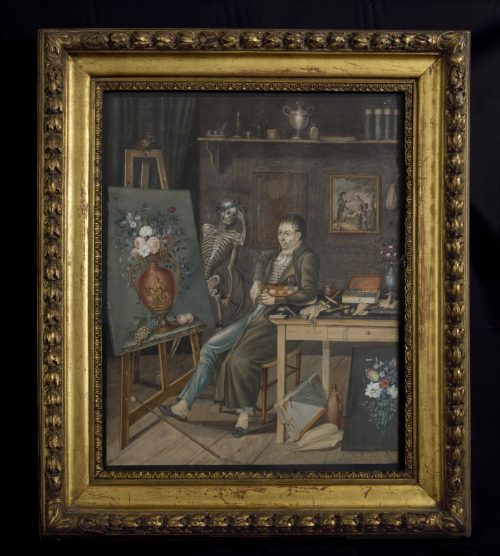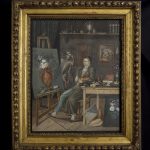9460 SELF-PORTRAIT BY JOHANN RUDOLF FEYERABEND, ALSO KNOWN AS “LELONG” (1779-1814) French. Nineteenth Century. Measurements: Width: 19″ (48cm); Depth: 2″ (5cm); Height: 22″ (56cm)

Research
Of gouache on paper within a carved giltwood frame. Under glass.
Marks:
Signed at the lower right
Joh. Rudolf Feyerabend Pixnit
Affixed to the back of the picture are the following documents:
A copy of the page containing the entry for Feyerabend (Johann Rudolff) from E. Bénézit’s Dictionnaire Critique et Documentaire des Peintres, Sculpteurs, Dessinateurs, et Graveurs.
A letter referring to the Bénézit entry
A handwritten description of the painting signed by Guillaume Dubois de la Cotardière.
Provenance:
Collection of Guillaume Dubois de la Cotardière, Blois, France.
An estate in Normandy.
This unusual gouache is an example of the genre in art specifically devoted to reminding us of our own mortality and the transience of earthly possessions. “Memento Mori,” from the Latin “Remember you will die,” is a genre found in painting and sculpture, particularly funeral art and architecture. The most popular symbols found in these works are skeletons or skulls. Extinguished candles, urns of flowers and timepieces such as clocks and hourglasses are also present as reminders of our fleeting existence in this world.
In this work, the artist, Johann Rudolf Feyerabend, also known as Lelong, (Basel, 1779-1814) depicts himself in his studio. On the canvas before him is painted an urn of flowers and fruits, characteristic symbols of memento mori painting. A symbol of night and sleep, the owl, is perched on the easel. An actual urn with flowers sits on the table above a second canvas of the same subject. Behind the easel stands a skeleton donning a laurel wreath, suggesting to the viewer that death will ultimately claim victory. The picture is remarkable for its witty interpretation of a memento mori, as death salutes to the viewer through the skeleton’s pose.
Feyerabend was the son and pupil of the painter Frans Feyerabend, who was a portrait painter in oil and gouache. Although he spent most of his life in Switzerland, Johann Rudolph spent some time in France, in the region of Caen, in the late 18th century, where the Normans, who had difficulty pronouncing his name, gave him the nickname “Lelong” based on his thin and tall stature.
Feyerabend’s work focused mainly on small still lifes of table tops with fruit, birds, vases of flowers and household or musical appurtenances. The present piece is the artist’s only known portrait.
This painting, signed Joh. Rudolf Feyerabend Pixnit, was formerly in the collection of the French lawyer, scholar and connoisseur Guillaume Dubois de la Cotardière (1866-1942). It was purchased in 1905, along with ten other gouaches signed “Lelong.” Through his research Dubois de la Cotardière put forth the now-accepted theory that Feyerabend and Lelong were one and the same person, as evidenced by the aesthetic similarities, subject matter and geographic locations in which paintings under both names were found. His research was published by Baron A. de Fleury in the Journal des Arts, May 29, 1920. It was the present painting that helped to provide the link between those works by Feyerabend and those signed Lelong. A handwritten notice is attached to the back of the painting, written by Guillaume Dubois de la Cotardière, and describes the tableau and its vanitas symbolism in detail.


Comments are closed.